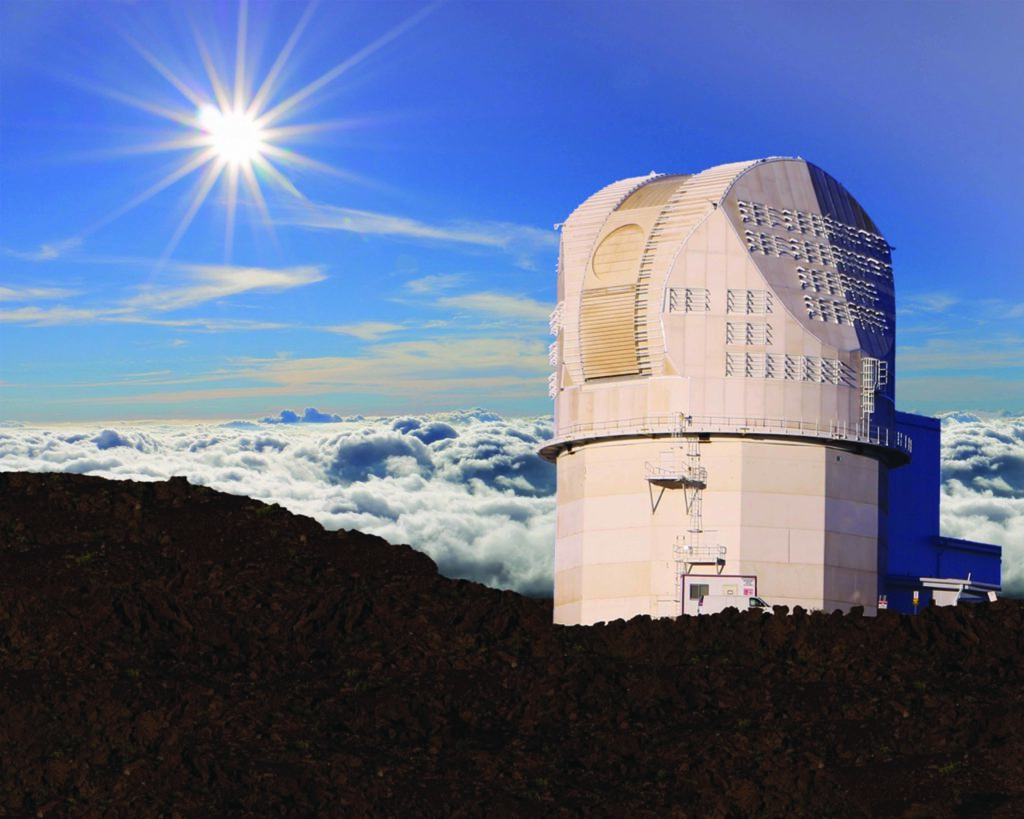Taking Our Understanding of the Sun into the Future
The Daniel K. Inouye Solar Telescope (DKIST) is set to revolutionize the field of solar physics once it begins operations in 2019. The National Solar Observatory (NSO) project is managed by the Association of Universities for Research in Astronomy (AURA) through a cooperative agreement with the National Science Foundation (NSF) and is currently under construction at the summit of Haleakalā on the island of Maui. While construction continues, scientists and engineers are busy developing and building the instruments that will change the face of solar physics.
Its 4-meter primary mirror will more than double the diameter of the current largest solar telescope—a position now held by the 1.6 meter New Solar Telescope at Big Bear Solar Observatory (BBSO) in California. The University of Hawai‘i at Mānoa’s Institute for Astronomy (IfA) is leading the development of two critical first-light instruments for DKIST. Both of these instruments will be pushing the boundaries of technology and solar science, providing never before seen views of the solar corona—the outermost layer of the Sun’s atmosphere.
The Diffraction Limited Near-Infrared Spectropolarimeter (or DL-NIRSP) is a specialized instrument designed to study the magnetic fields of the solar corona, chromosphere, and photosphere, and is led by Dr. Haosheng Lin of IfA. Leveraging technological advancements in telecommunications, this instrument utilizes specialty optical fiber bundles and ultra-narrow band filters to gather both spectral and spatial data from the Sun simultaneously. This is the first time the field of solar physics will have a facility-class instrument capable of providing simultaneous multi-wavelength data across a two-dimensional field.
The Cryogenic Near-Infrared Spectropolarimeter (Cryo-NIRSP) will also be focused on the coronal magnetic fields. Unlike DL-NIRSP, this instrument will be cryogenically cooled to reduce the thermal background produced by the optics and electronics themselves, facilitating observations into the mid-infrared. This is a region of the solar spectrum that has largely been ignored until now. This instrument team is led by Dr. Jeffrey Kuhn at IfA, who is a co-investigator of DKIST, and has the potential to obtain precise measurements of the Sun’s coronal magnetic field strength with fidelity never before achieved. Until now, scientists have depended on mathematical models and surface extrapolations to theorize the magnetic field strength in the corona. Cryo-NIRSP will revolutionize this process by actually measuring the Sun’s coronal magnetic field, providing a vital leap forward in understanding solar activity that leads to space weather predictions.
“The DL-NIRSP and Cryo-NIRSP are the largest and most complex astronomical instruments built by IfA,” said Guenther Hasinger, director of the Institute for Astronomy. “We are proud of our contributing efforts led by Drs. Lin and Kuhn and their respective teams in helping to bring the world’s largest daytime telescope on-line.”
Three other instruments will complete DKIST’s first-light suite. The Visible Broadband Imager (led by NSO), the Visible Spectropolarimeter (led by the High Altitude Observatory) and the Visible Tunable Filter (led by the Kiepenheuer Institute for Solar Physics (KIS) in Germany) will round out the observatory’s initial complement of instruments.
The technological advancements required for a 4-meter primary mirror on a solar telescope are numerous, with cooling challenges at the top of the list. Up to 12,000 Joules of energy (12 kilowatts) will need to be removed from the prime focus of this telescope each second, requiring a combination of advanced materials and powerful heat exchangers. The observatory will produce multiple large vats of ice every night that will chill the air and liquid coolants running throughout the observatory. At the prime focus heat-stop, a unique metallic sponge is continuously cooled by fire-hoses worth of dynalene flowing through its fibers. Should the coolant stop flowing, there would be only a few minutes before the entire system would overheat causing significant damage. Thus, the series of rigorous emergency shut-offs and automated monitors are as essential to the success of the project as the cooling systems themselves.
Another vital technological achievement involved the adaptive optics (AO) systems, developed by a team of NSO, BBSO and KIS scientists. These are feedback systems that enable deformable mirrors to adapt to changes in the Earth’s atmosphere 1000s of times a second, resulting in significantly clearer images. DKIST is pioneering a Multi-Conjugate Adaptive Optics system that employs three sequential deformable mirrors, allowing us to observe more detail on the Sun’s surface than any other ground-based technique. Classical adaptive optics systems can provide a clear area of approximately 7,000 x 7,000 km (about the size of the smallest sunspots), but the mastery of the DKIST system has increased this area to 40,000 x 40,000 km on the Sun’s surface.
“Overall, DKIST will be a technological masterpiece, with synergies between hardware and software keeping the entire system in balance,” said Dr. Thomas R. Rimmele, project director of DKIST. “But it is the human understanding that will push it into the future.”
Above, right: Dr. Haosheng Lin, DL-NIRSP instrument project lead. Photo: UH
Above, left: The Cryo-NIRSP instrument undergoing tests in its clean-room environment. From left, Drs. Andre Fehlmann, Jeff Kuhn and Isabelle Scholl. Photo: UH

